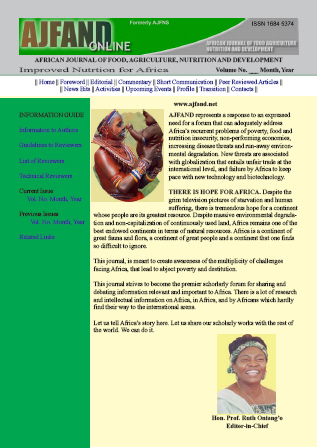
|
African Journal of Food, Agriculture, Nutrition and Development
Rural Outreach Program
ISSN: 1684-5358
EISSN: 1684-5358
Vol. 13, No. 2, 2013, pp. 7562-7586
|
 Bioline Code: nd13033
Bioline Code: nd13033
Full paper language: English
Document type: Research Article
Document available free of charge
|
|
|
African Journal of Food, Agriculture, Nutrition and Development, Vol. 13, No. 2, 2013, pp. 7562-7586
| en |
POTENTIALS OF HYBRID MAIZE VARIETIES FOR SMALL-HOLDER FARMERS IN KENYA: A REVIEW BASED ON SWOT ANALYSIS
Schroeder, C; Onyango K'Oloo, T; Nar Bahadur, R; Jick, NA; Parzies, HK & Gemenet, DC
Abstract
Maize is the primary staple crop in Kenya and plays an important role in the livelihood of the people of Kenya. Its availability and abundance determines the level of welfare and food security in the country. In Kenya, future increases in maize production to meet domestic demand will have to rely on improvements in yield per hectare rather than on the expansion of maize production area. Enhanced maize productivity can be achieved by increased use of modern production techniques such as the adoption of hybrid maize varieties, the use of chemicals and fertilizer application. Small-scale maize prodcution plays a major role in Kenya’s maize economy and adoption of hybrid technology by small-scale farmers would have the potential to address sustainability and supply issues. However, such modern technologies are still rarely used by Kenya’s small-scale farmers, particularly by those in marginal areas. This study, therefore, tries to review the reasons for the low rate of adoption of hybrid maize varieties among small-scale farmers with focus on those smallholders in Kenya’s marginal areas. Lack of awareness of existing or newly released hybrid varieties, lack of hybrid varieties adapted to marginal areas, lack of confidence in the quality of some hybrid maize seeds, poor access to stockists, low profitability due to high seed cost, inadequate access to credit, the need for fertilizer application and low literacy level have been found to be important factors explaining the low adoption rates by smallholder maize producers in marginal areas. In addition, these constraints might also explain the widespread practice of recycling hybrid grain among small-scale farmers once they have adopted hybrid maize varieties. Therefore, it is hoped that by overcoming these constraints, the adoption of hybrid maize varieties among smallholder farmers could be greatly enhanced, which in turn could lead to a significant positive impact on the country’s food security situation.
Keywords
Adoption; maize hybrids; small-scale farmers
|
| |
© African Journal of Food, Agriculture, Nutrition and Development
Alternative site location: http://www.ajfand.net/
|
|
